How to See What Group Policies Are Applied to Your Windows 11
Have you ever wondered what secret rules your Windows 11 system follows? Understanding the intricacies of Group Policies can help figure this out. Group Policies play a crucial role in managing the behavior of your Windows environment. This article will guide you through four ways to see what Group Policies are applied to your Windows 11.
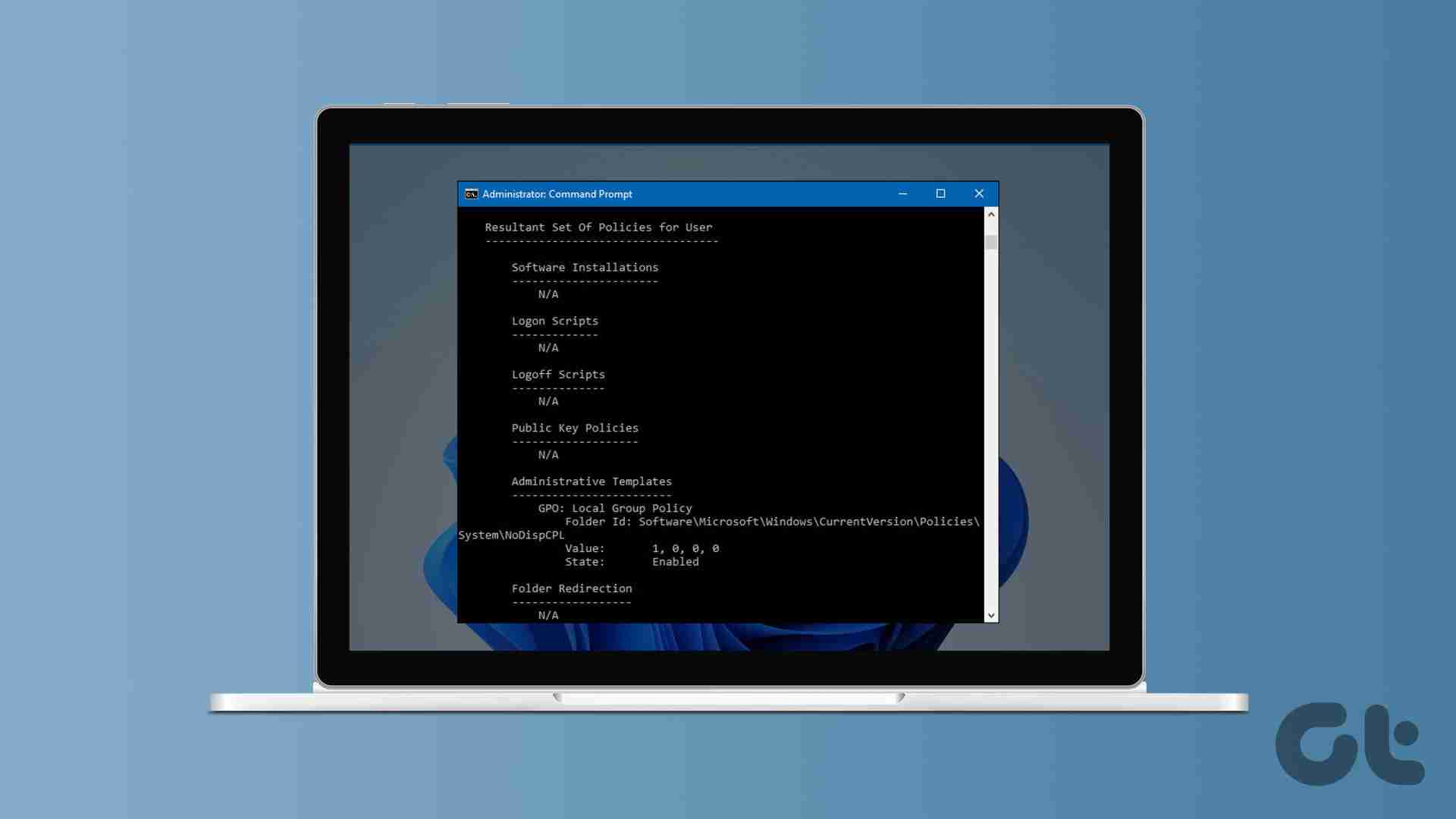
But before we dive into the specifics, let’s take a moment to understand Group Policy in Windows. It’s like a set of rules dictating your operating system’s behavior. The Group Policy system allows administrators to enforce specific rules and restrictions, ensuring a standardized, secure computing environment. Now, let’s understand different ways to view and check the GPO applied on your Windows 11.
Note: Group Policy Editor is only available for Windows 11 Pro and Enterprise versions. If you use the Home edition, you won’t have access to the Local Group Policy Editor.
1. View Applied Group Policies Using Local Group Policy Editor’s State Option
This is one of the most common and safest ways to find all the enabled, disabled, and not configured policies on your Windows 11 machine. Follow the below-mentioned steps.
Step 1: Press the Windows keys on your keyboard, type gpedit.msc, and click Open.
Note: Press Windows key R to open the Run dialog box, type gpedit.msc, and click OK.

Step 2: Select Computer Configuration under ‘Local Computer Policy’ in the left pane and expand Administrative Templates.
Step 3: Now, click the All Settings folder.

You should see all the settings in listicle format in the right pane. Click on the State column to bring the enabled options to the top. You can follow the usual method to make changes if required.

If you wish to view only the configured policies or focus on a specific type of policy on Windows 11, proceed to the following method.
Also Read: Best ways to open Local Group Policy Editor in Windows 11
2. Check GPO Applied Using the Filter in Local Group Policy Editor
Microsoft has included a filter feature in the Local Group Policy Editor so that you can quickly find the policies and change things accordingly. Follow the below steps.
Step 1: Press the Windows keys on your keyboard, type gpedit.msc, and click Open.
Note: Press Windows key R to open the Run dialog box, type gpedit.msc, and click OK.

Step 2: Select Computer Configuration under ‘Local Computer Policy’ in the left pane and expand Administrative Templates.
Step 3: Now, choose the All Settings folder and click on Action from the toolbar.
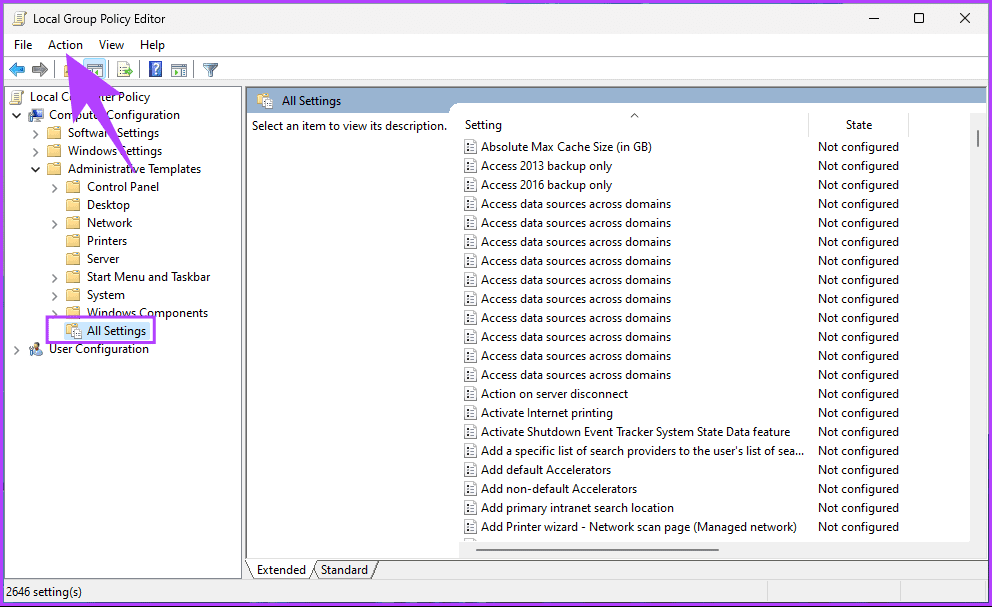
Step 3: Select Filter Options from the drop-down menu.
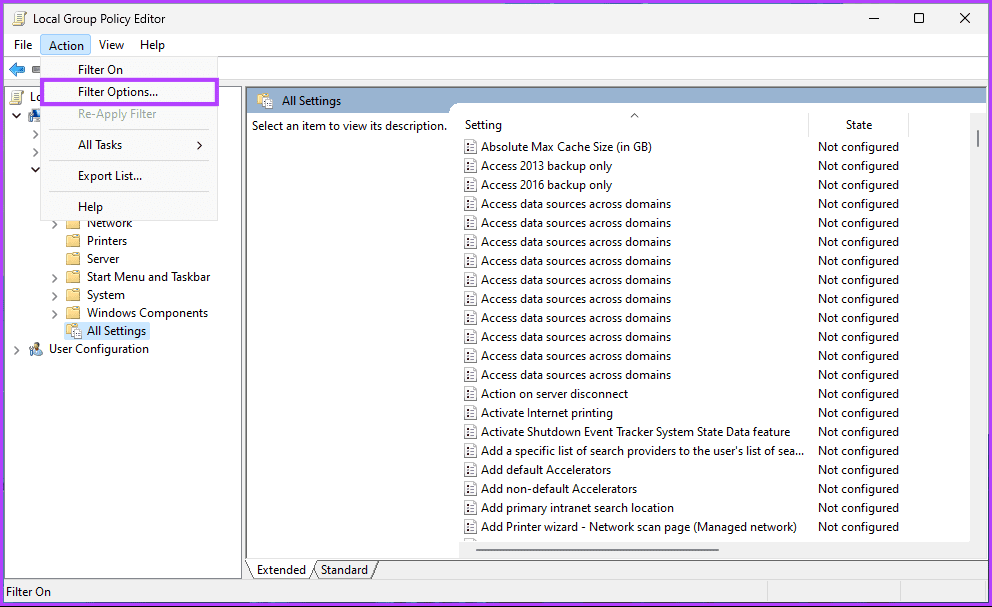
Step 4: In the Filter Options dialog box, select Yes under the Configured drop-down and click OK.
Note: You can also use Keyword Filters by enabling them and looking for a specific Policy title.
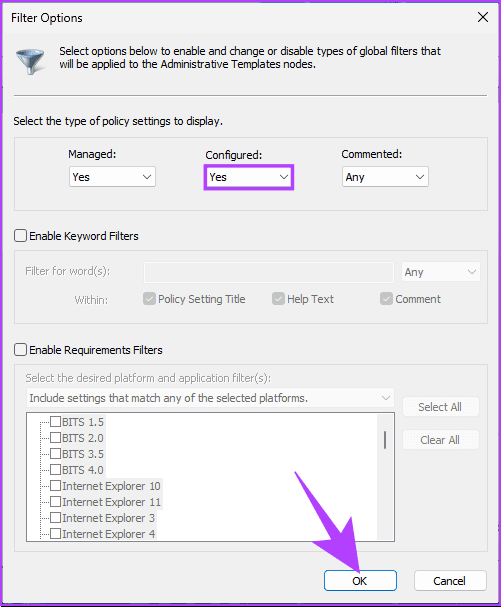
There you go. You have filtered policies enabled on your Windows 11. If you want to know another method to view or check the GPO applied to your Windows 11 machine, continue reading.
3. View Applied Group Policies Using Resultant Set of Policy Tool (rsop.msc)
RSOP.msc is a built-in tool on Windows 11 that allows users to see all the Group Policy settings applied to their computer.
Step 1: Press the Windows key on your keyboard, type rsop.msc, and click Open.
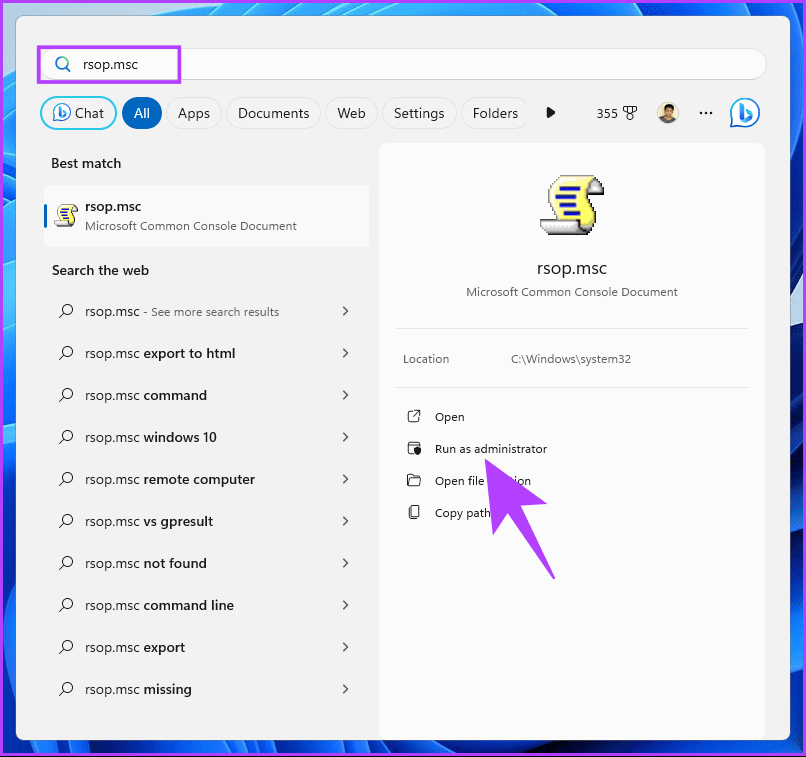
The Resultant Set of Policy tool will start the scan for applied Group Policy settings.
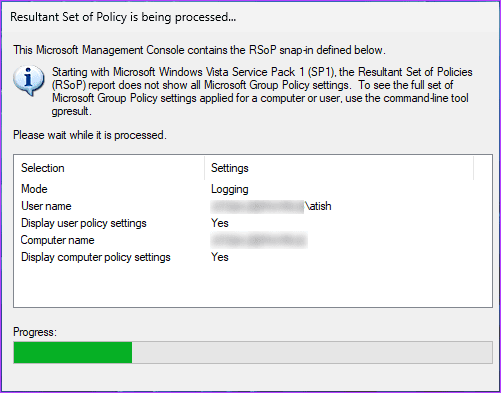
Upon scanning, the tool will display a management console similar to the Local Group Policy Editor, except it only displays enabled settings and a few unconfigured security settings.
Step 2: Navigate to the folder to check which settings are applied to your computer.
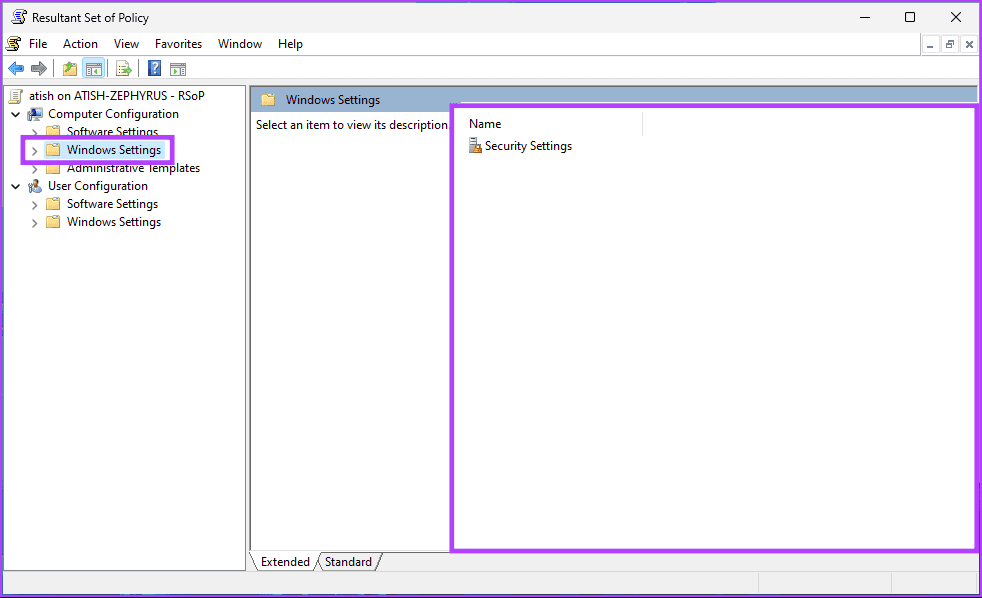
You must note that you cannot use the Resultant Set of Policy tool to change settings. You can only view the details by double-clicking a setting. If you want to make any changes, launch the Local Group Policy and start making the changes.
Also Read: Top ways to reset Local Group Policy settings on Windows 11
4. View Applied Group Policies With Command Prompt
If you are comfortable using command-line tools such as Command Prompt or Terminal, this method would be a great choice. Let’s begin with the steps.
Step 1: Press the Windows key on your keyboard, type PowerShell, and click ‘Run as administrator.’
In the prompt, select Yes.
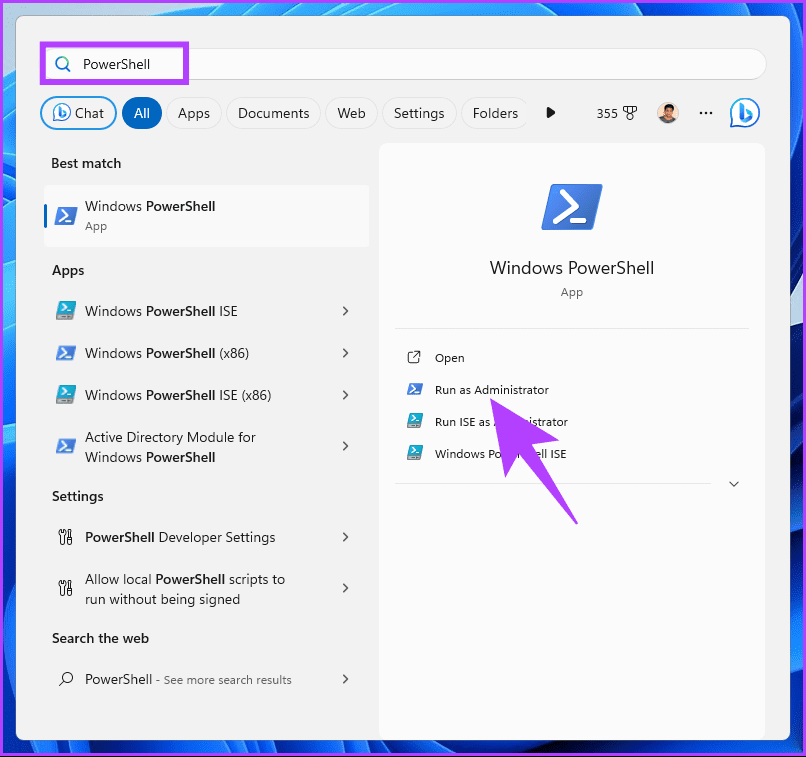
Step 2: Type (or copy-paste) the below command and press Enter.
gpresult /Scope User /v
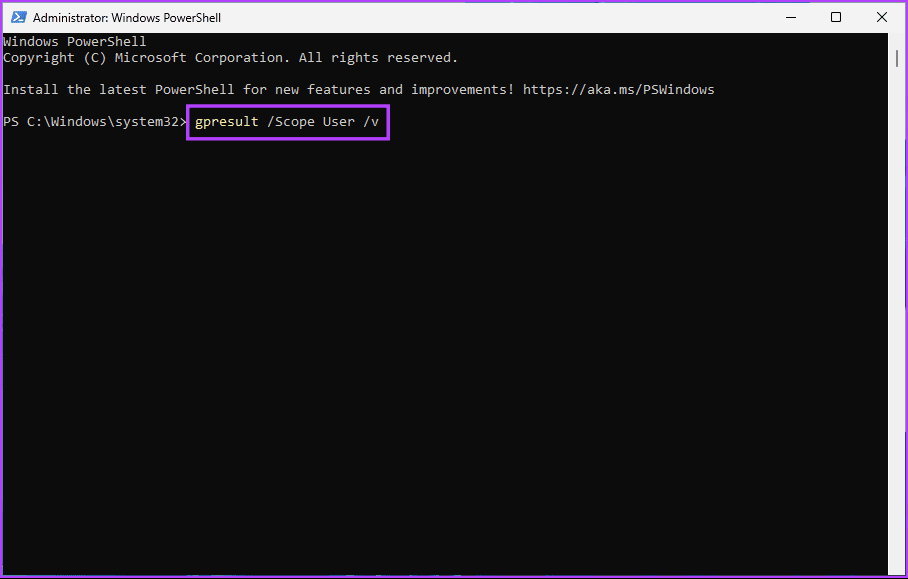
There you go. The gpresult command will show all the policies applied to your Windows 11 PC, which, if you want, you can export to a file for future use. That said, if you have any queries, check out the FAQ section below.
FAQs on Seeing What Group Policies Are Applied
Yes, you can use the gpresult /r /computer
Yes, you can export Group Policy settings using the Group Policy Management Console. Right-click on the Group Policy Object (GPO) > select Backup to create a backup of the GPO settings. This backup can be used for documentation or restoration purposes.
You can use the gpresult /user
Know Applied Policies in Windows
From controlling security settings to shaping the user interface, Group Policies are the backbone of centralized management in Windows environments. Now that you know what Group Policies are applied on Windows 11, take charge of your system’s behavior and make it work. You can also read these top ways to back up the Local Group Policy Editor on Windows 11.
-
 How to delete your data from a person search siteThis article was last updated on February 24, 2025. Many people are unaware that a significant amount of their personal data is readily accessible on...Software tutorial Posted on 2025-04-21
How to delete your data from a person search siteThis article was last updated on February 24, 2025. Many people are unaware that a significant amount of their personal data is readily accessible on...Software tutorial Posted on 2025-04-21 -
 How to disguise an iPad as a laptopThis updated article (originally published October 31, 2019) explores how to transform your iPad into a laptop alternative using iPadOS 16 beta featur...Software tutorial Posted on 2025-04-21
How to disguise an iPad as a laptopThis updated article (originally published October 31, 2019) explores how to transform your iPad into a laptop alternative using iPadOS 16 beta featur...Software tutorial Posted on 2025-04-21 -
 How to clean Mac mailbox cache? How to delete it on Mac?This guide explains how to clear the Mail cache on your Mac, addressing common issues like slow performance and email loading problems. The macOS Mai...Software tutorial Posted on 2025-04-21
How to clean Mac mailbox cache? How to delete it on Mac?This guide explains how to clear the Mail cache on your Mac, addressing common issues like slow performance and email loading problems. The macOS Mai...Software tutorial Posted on 2025-04-21 -
 How to prioritize the allocation of WiFi to the most needed devicesModern homes usually have multiple devices connected to Wi-Fi access networks simultaneously, which often leads to bandwidth tightness, especially w...Software tutorial Posted on 2025-04-19
How to prioritize the allocation of WiFi to the most needed devicesModern homes usually have multiple devices connected to Wi-Fi access networks simultaneously, which often leads to bandwidth tightness, especially w...Software tutorial Posted on 2025-04-19 -
 McAfee antivirus software review: Is it enough? 【Function, Price】McAfee: A Veteran Antivirus, But Is It the Best for Macs? McAfee, a long-standing and reputable name in cybersecurity, offers a robust antivirus suite...Software tutorial Posted on 2025-04-19
McAfee antivirus software review: Is it enough? 【Function, Price】McAfee: A Veteran Antivirus, But Is It the Best for Macs? McAfee, a long-standing and reputable name in cybersecurity, offers a robust antivirus suite...Software tutorial Posted on 2025-04-19 -
 OnePlus Watch 3 is postponed to April due to funny issuesAfter the long-awaited OnePlus Watch 3 smartwatch is released, the purchase plan may require a slight adjustment. A ridiculous production problem has...Software tutorial Posted on 2025-04-19
OnePlus Watch 3 is postponed to April due to funny issuesAfter the long-awaited OnePlus Watch 3 smartwatch is released, the purchase plan may require a slight adjustment. A ridiculous production problem has...Software tutorial Posted on 2025-04-19 -
 Tips to make the most of the tap function on the back of your iPhoneOver the years, Apple has developed a large number of tools to make using iPhones more convenient. Although the "Tap Back" feature is dull,...Software tutorial Posted on 2025-04-18
Tips to make the most of the tap function on the back of your iPhoneOver the years, Apple has developed a large number of tools to make using iPhones more convenient. Although the "Tap Back" feature is dull,...Software tutorial Posted on 2025-04-18 -
 Quickly get Windows 11 24H2 updates, skip the waiting queueIn the comprehensive guide, MiniTool will walk you through how to bypass Windows 11 24H2 waiting line using Group Policy and Registry. Take action if ...Software tutorial Posted on 2025-04-18
Quickly get Windows 11 24H2 updates, skip the waiting queueIn the comprehensive guide, MiniTool will walk you through how to bypass Windows 11 24H2 waiting line using Group Policy and Registry. Take action if ...Software tutorial Posted on 2025-04-18 -
 Tips for using mobile phone hotspots: How to avoid the surge in data trafficUsing your phone as a hotspot for your laptop on the go is convenient, but laptops are data hogs. Unlike phones, which prioritize Wi-Fi for tasks like...Software tutorial Posted on 2025-04-18
Tips for using mobile phone hotspots: How to avoid the surge in data trafficUsing your phone as a hotspot for your laptop on the go is convenient, but laptops are data hogs. Unlike phones, which prioritize Wi-Fi for tasks like...Software tutorial Posted on 2025-04-18 -
 Which one is better compared to iPhone and Android?Choosing between iOS and Android: A Detailed Comparison The mobile phone market is dominated by two major players: iOS and Android. Both boast millio...Software tutorial Posted on 2025-04-17
Which one is better compared to iPhone and Android?Choosing between iOS and Android: A Detailed Comparison The mobile phone market is dominated by two major players: iOS and Android. Both boast millio...Software tutorial Posted on 2025-04-17 -
 Safari slows down on Mac? The secret to speeding up safari!Safari browser runs slowly? A must-see guide to acceleration for Mac users! Safari is one of the fastest browsers on Mac, but it is also not complete...Software tutorial Posted on 2025-04-17
Safari slows down on Mac? The secret to speeding up safari!Safari browser runs slowly? A must-see guide to acceleration for Mac users! Safari is one of the fastest browsers on Mac, but it is also not complete...Software tutorial Posted on 2025-04-17 -
 I thought I would never need a wallet until this happenedYou’re in a nice restaurant with your beloved; perhaps both of you are enjoying a lovely steak. After a while, you raise your hand and ask the waiter ...Software tutorial Posted on 2025-04-17
I thought I would never need a wallet until this happenedYou’re in a nice restaurant with your beloved; perhaps both of you are enjoying a lovely steak. After a while, you raise your hand and ask the waiter ...Software tutorial Posted on 2025-04-17 -
 Comparison between McAfee and MacKeeper: Which one is better? How to choose antivirus software?Choosing the right cybersecurity solution for your Mac can be tricky. This comparison of McAfee and MacKeeper helps you decide between a well-establi...Software tutorial Posted on 2025-04-17
Comparison between McAfee and MacKeeper: Which one is better? How to choose antivirus software?Choosing the right cybersecurity solution for your Mac can be tricky. This comparison of McAfee and MacKeeper helps you decide between a well-establi...Software tutorial Posted on 2025-04-17 -
 7 security communication apps you should useChoosing a messaging app often boils down to what your contacts use, overlooking a crucial factor: security. We share incredibly sensitive informatio...Software tutorial Posted on 2025-04-17
7 security communication apps you should useChoosing a messaging app often boils down to what your contacts use, overlooking a crucial factor: security. We share incredibly sensitive informatio...Software tutorial Posted on 2025-04-17 -
 The ultimate guide to how to label any websiteBeyond Static: Annotating Web Pages with Ease The web shouldn't be a static experience. With the right tools, you can actively engage with websit...Software tutorial Posted on 2025-04-17
The ultimate guide to how to label any websiteBeyond Static: Annotating Web Pages with Ease The web shouldn't be a static experience. With the right tools, you can actively engage with websit...Software tutorial Posted on 2025-04-17
Study Chinese
- 1 How do you say "walk" in Chinese? 走路 Chinese pronunciation, 走路 Chinese learning
- 2 How do you say "take a plane" in Chinese? 坐飞机 Chinese pronunciation, 坐飞机 Chinese learning
- 3 How do you say "take a train" in Chinese? 坐火车 Chinese pronunciation, 坐火车 Chinese learning
- 4 How do you say "take a bus" in Chinese? 坐车 Chinese pronunciation, 坐车 Chinese learning
- 5 How to say drive in Chinese? 开车 Chinese pronunciation, 开车 Chinese learning
- 6 How do you say swimming in Chinese? 游泳 Chinese pronunciation, 游泳 Chinese learning
- 7 How do you say ride a bicycle in Chinese? 骑自行车 Chinese pronunciation, 骑自行车 Chinese learning
- 8 How do you say hello in Chinese? 你好Chinese pronunciation, 你好Chinese learning
- 9 How do you say thank you in Chinese? 谢谢Chinese pronunciation, 谢谢Chinese learning
- 10 How to say goodbye in Chinese? 再见Chinese pronunciation, 再见Chinese learning

























